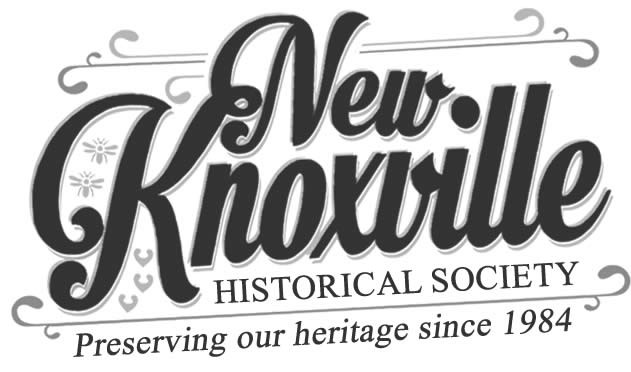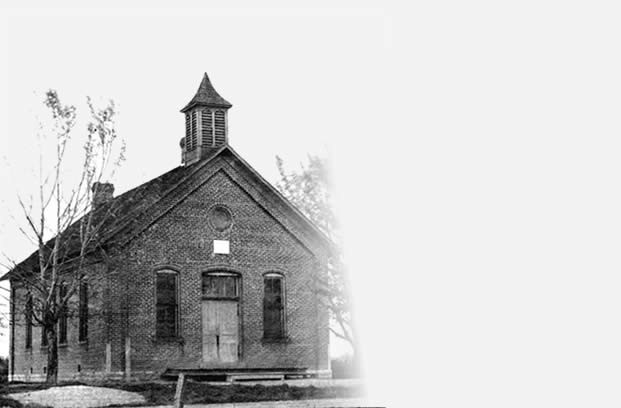Written by Doug Hoelscher in 2016
(With information from the Church Centennial and Sesquicentennial publications.)
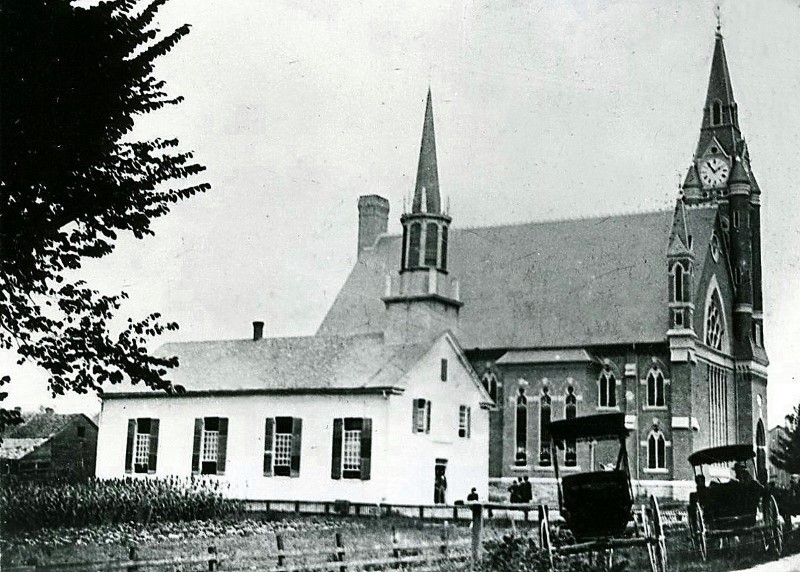
The 1853 frame building was moved westward to clear space for the new 1894 Noll Church.
First Church had its beginnings in the 1830’s with German immigrants coming to the United States from the Evangelical Reformed Church in Ladbergen, Germany. The congregation was formed in 1838 with 40 charter members. (40 names of men are listed, and it is assumed that wives were included in the congregation). They began meeting at homes intermittently when the services of circuit rider Pastor Frederick Jaertin were available from 1838-1840. From 1840 to 1841 Johannes Tanke became the visiting minister, and from 1841-1843 he became the Resident Minister.
In 1840 the first church building and parsonage were built, both log buildings. The Old Reformed cemetery was established on South Street in 1840, and it was used until 1896 when the Pilger Ruhe Cemetery was established west of the village. Pilger Ruhe (Pilgrims Rest) cemetery does not belong to the congregation, but is operated by a separate board of directors with a paid caretaker and a perpetual care fund. In 1841 the first constitution of the congregation was adopted and signed by Rev. J. H. Tanke and the forty founding fathers of the church. Also 1841 saw the arrival of F. H. W. Kuckhermann who was a school teacher and lay minister. In 1847 he became a licensed minister, and he continued to serve in that capacity until 1890. In 1842 the first confirmation class with six members was confirmed by Rev. J. H. Tanke. The first consistory record on May 4, 1846 named one elder and three deacons. In 1853 the present church site was purchased, and a frame church building was erected. In 1858 the log cabin parsonage was replaced by a frame house. In 1865 two acres of ground were sold, and the proceeds were used to build a parochial school for youth education including confirmation instruction.
Until 1874 the church operated as an independent non-denominational congregation, but in that year it became affiliated with the Reformed Church in the United States. 1875 saw the first student of the congregation to enter full time Christian service. In 1880 the Branch Sunday School was organized at the George Clausing home north of New Knoxville. In 1901 a building was erected for this purpose along what is now the Washington Pike north of New Knoxville. This Sunday School continued to meet until 1919 when automobiles became the primary form of transportation and members could easily drive to town for Sunday School meetings which were held on Sunday afternoons. In 1888 the third parsonage was built, a brick house which still stands today at 305 W. Bremen Street.
Rev. Kuckhermann resigned in 1890 and was elected Pastor Emeritus. He continued to be active in church and other community activities for the next 25 years. He was replaced by Rev. Abraham Schneck, who served until 1892, and he was followed by Rev. Moritz Noll. 1893 saw the formation of the Ladies Aid Society followed by the Young Peoples’ Society in 1916, and the Mens’ Brotherhood in 1919. Also in 1893 the frame church building was moved westward into what is now the parking lot to make room for the new Noll brick church, which was dedicated August 26, 1894. This is the building which has been in continuous use from then until the present time with three additions. In 1913 the Friedli addition was dedicated on the west side of the Noll church for Sunday School rooms, and the Kunst addition was dedicated on the east side in 1923 for additional seating in the sanctuary. In 1928 the current brick parsonage was constructed to the west of the 1888 parsonage.
Ministers who served the congregation in its first hundred years are as follows:
| Frederick Jaertin—Visiting Minister | 1838-1840 |
| Johannes H. Tanke—Visiting Minister | 1840-1841 |
| Johannes H. Tanke—Resident Minister | 1841-1843 |
| Frederick Herman Wilhelm Kuckhermann --Lay Minister | 1844-1847 |
| Frederick Herman Wilhelm Kuckhermann --Licensed Minister | 1847-1852 |
| Frederick Herman Wilhelm Kuckhermann --Ordained Minister | 1852-1890 |
| >Abraham Schneck | 1890-1892 |
| Moritz Noll | 1892-1898 |
| John Bachmann | 1899-1910 |
| J. J. Janett | 1910 |
| Josias Friedli | 1915-1933 |
| Otto B. Moor | 1933-1940 |
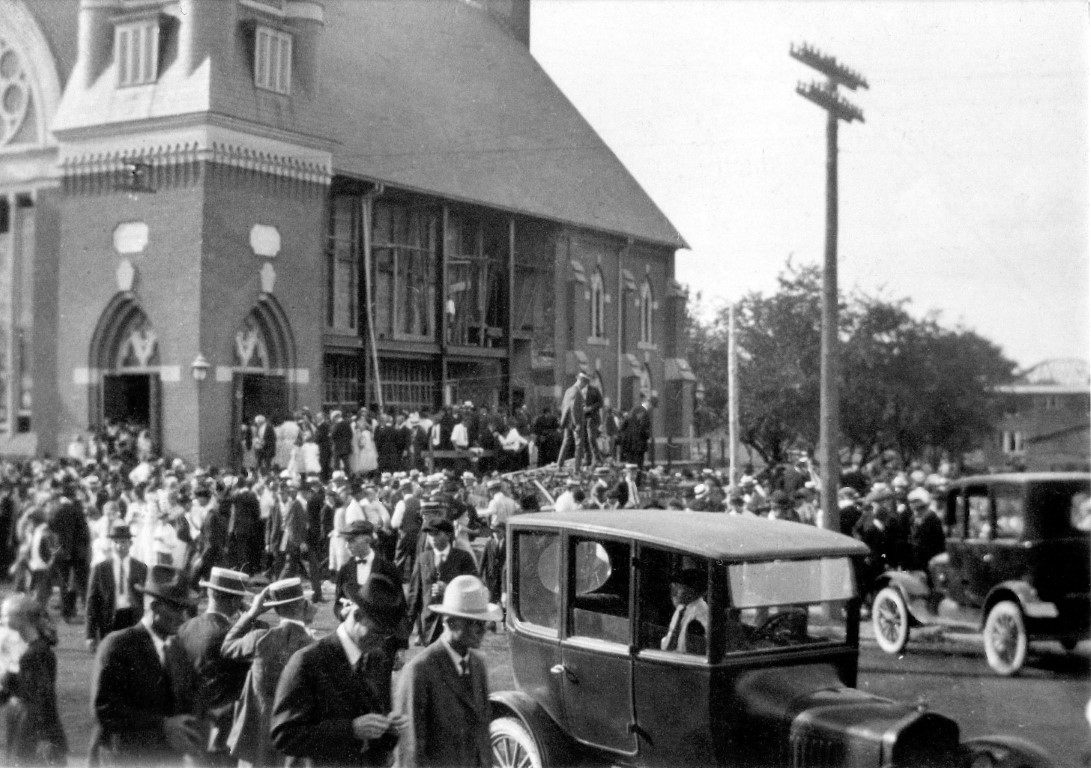 Construction has started on the 1923 Kunst addition to the east side.
Construction has started on the 1923 Kunst addition to the east side.In 1934 the congregation became a part of the Evangelical and Reformed Church through the merger of those two denominations. In 1938 the congregation had a Centennial celebration with two Sundays of morning and evening services and evening services every day between the two Sundays. Sermons were furnished by guest ministers and past ministers of the congregation. Mrs. Cornelia Schroer, a missionary sent out from the congregation presented a missionary drama on Saturday evening with a cast of members of the congregation. A very nice Centennial souvenir book was published recording the history of the church for the first hundred years and showing many pictures of the buildings and groups of people within the church.
Membership and attendance continually grew during the first hundred years. When Rev. Moritz Noll started his service in 1892 the congregation had 581 members, and a Sunday School of 360 including the Chapel on Washington Pike. By 1898 membership had grown to 719 with a Sunday School of 455. The 1938 Centennial book states that the membership was 1008 with a Sunday School enrollment of 872. Average Sunday morning worship attendance was 800 with a Sunday evening service attendance of 225.
The people gradually assimilated into the English culture. In 1923 two Sunday evening services per month were in the English language. In 1932 all services were in English except the first and third Sunday morning services of each month. Some services were presented in German until 1943, and some Sunday School classes and Bible study groups continued to use German for some time after that.
Through the years the church has been involved in church planting and assisting neighboring congregations. In the 1850s some residents of New Knoxville began to move west to Iowa and Minnesota. First Church members who moved to LeSueur, MN became a part of Zion Evangelical Church. Members who moved to Garner, Iowa helped to organize the Peace Reformed Church (Friedens Gemeinde) to which First Church in New Knoxville gave some financial assistance. During the service of Rev. Abraham Schneck in 1890-91 some dissension developed in the congregation, and one third of the members of First Church along with Rev. Schneck formed the Emmanuel Lutheran Church. They first worshipped on Sunday afternoons in what was then a Methodist church building, and they built their own brick building in 1891 and a parsonage in 1892. In 1883 the German Reformed Friedens-Gemeinde of Van Buren Township in Shelby County, Ohio was started. The New Knoxville congregation bought a property with a church building formerly used by a Methodist group. The last minister to serve the Friedens Gemeinde church was from 1911-1912, when presumably the use of the automobile enabled congregants to attend other larger churches. The cemetery on this property located along Botkins Road is still owned by the New Knoxville congregation, and neighborhood volunteers mow it. In 1897 and 1898 contributions were given to the building fund of the Zion Church in New Bremen. Along with church planting, many sons and daughters of the congregation were sent out to serve the Lord. In the first 100 years 38 sons and daughters of the congregation went into the ministry, mostly as ordained ministers and including missionaries to Japan. In the 25 years from 1938 to 1963 sixteen more were added to that list, including a missionary to Africa. From 1963 to present at least 10 more have been added including a missionary family to Africa. The 1988 Sesquicentennial book lists 35 women of the congregation who married ministers.
Pastors who have served the church since the first 100 years are as follows:
| Dietrich A. Bode | 1941-1956 |
| Frank J. Lowenbergh | 1956-1961 |
| Richard B. Meckstroth (Interim) | 1962 |
| John M. Michael | 1962-1964 |
| Kenneth Worthman | 1965-1975 |
| Gary A. Kwiatek | 1975-1977 |
| Richard W. Sather | 1978-1983 |
| Leonard Cook (Interim) | 1983-1984 |
| Jon R. Coddington | 1984-1990 |
| Nathan B Wierwille (Interim) | 1990-1991 |
| David Hunt | 1991-2005 |
| David A. Williams | 2006-2014 |
| Beth Ernest (Transitional) | 2014-Present |
In 1950 the congregation of First Church sent Rev. and Mrs. D. A. Bode to Ladbergen, Westphalia, Germany as the church’s official representatives at the 1000th anniversary celebration of the “mother church”. Also in 1950, the New Knoxville church was recognized in Life Magazine as one of the “Twelve Great Churches in America”. In this same year First Church financed the furnishing of a double room at the newly built Joint Township District Hospital located in nearby St. Marys.
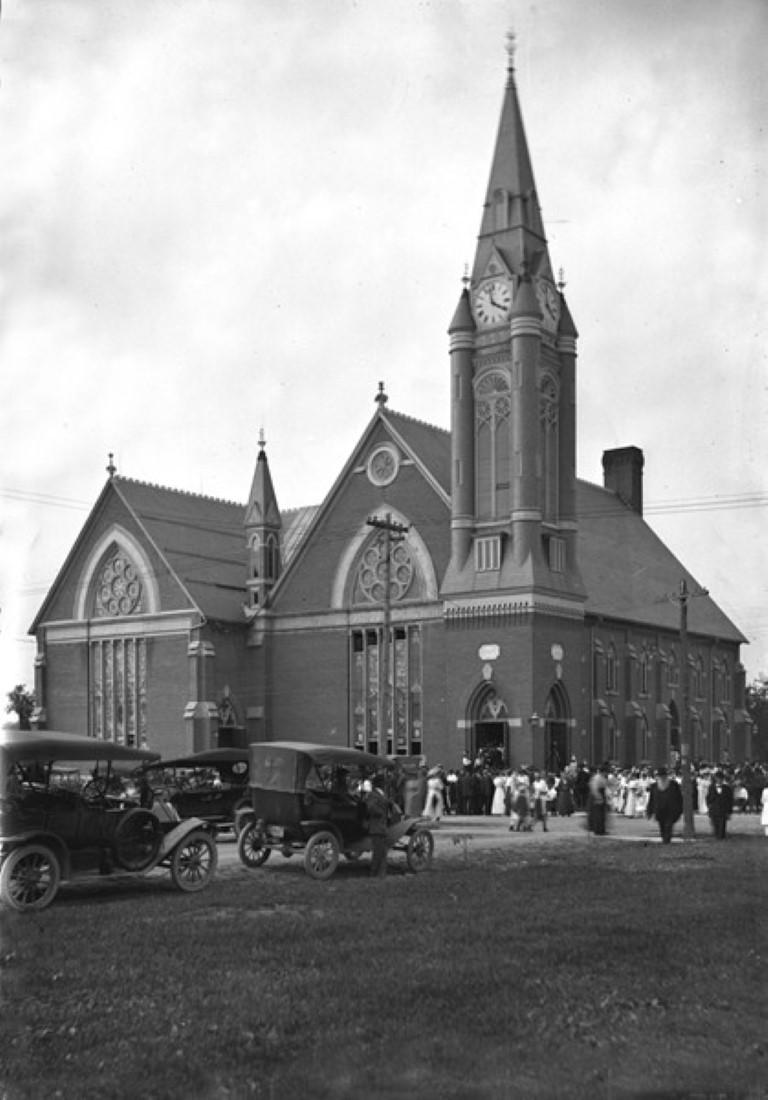 After the completion of the 1913 Friedli addition on the west side.
After the completion of the 1913 Friedli addition on the west side.With the merger of the Evangelical and Reformed and the Congregational Christian denominations in 1957 the church became the First United Church of Christ of New Knoxville, which it remained in name until 2014 when the congregation voted by an overwhelming majority to leave the United Church of Christ denomination. By that time the church had operated almost independently for many years. Instead of sending the majority of benevolent funds to the denomination, the church adopted a designated offering policy which is reviewed and changed annually by a committee formed for that purpose. In 2015 much time was spent investigating several possibilities for denominational affiliation by a transitional team comprised of the pastoral search committee, the six current elders, two former elders, and the transitional pastor. The committee recommended that First Church remain non-denominational for the forseeable future. In December of 2015 the congregation voted to enlist the services of MinisterSearch to aid in the finding and hiring of a new Senior Pastor.
In 1965 First Church began to broadcast its Sunday morning services live on WERM radio via telephone lines. The regular 9 AM Sunday morning service is broadcast today from a recording on WIMT radio in Lima, Ohio. The radio station claims 8000 weekly listeners of this broadcast. In 1971 the house directly to the north of the church building was purchased, and the church office and Pastor’s study were moved to the house in 1976. In 1995 the new northwest entrance to the church building was added for better access to the basement. In 2011 the old building housing the church office was razed, and the new Ministry Center was constructed. The Ministry Center houses the church offices, Pastor’s study, conference rooms, a youth room, a food catering and prep room, and a large multipurpose room that is used for church and community events and activities.
Through the years several youth ministers and directors have come and gone, and various youth programs have been developed. In 2015 Miss Victoria Russell was hired as the Children and Youth Director, and she is developing new programs and teaching Catechism along with Pastor Beth Ernest. The youth have opportunities to earn money through nursery service, car washes, and other community services to apply to their summer camps and other fun activities. In June the church hosts an annual five-day community Vacation Bible School in cooperation with the local United Methodist Church. This event is attended by 150-200 children and is conducted with approximately 75 volunteers. After local high school basketball games the Ministry Center is host to the “Fifth Quarter” which is a fun time for the youth of the community.
For approximately 8 years Church members packed and shipped care packages monthly to US servicemen overseas in Iraq and Afghanistan. The materials in these care packages were donated by members or purchased with donated money. Once a month volunteers from First Church serve food at the Daily Bread soup kitchen in Lima, Ohio. During Rev. David Hunt’s pastorate he took youth and adults on various mission trips including disaster relief in flood stricken areas.
Today the church has numerous childrens’ Sunday School classes, a couple of adult Sunday School classes, a Wednesday night gathering for prayer and Bible study/discussion, a fellowship group for Grand Adults, and there are several community womens’ prayer groups and Bible study groups.
